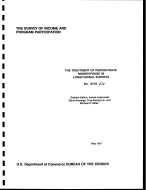The Treatment of Person-Wave Nonresponse in Longitudinal Surveys
The Treatment of Person-Wave Nonresponse in Longitudinal Surveys
Introduction
This report contains the findings of research conducted under a Joint Statistical Agreement between the Bureau of the Census and the Survey Research Center, University of Michigan, entitled "The Treatment of Person-Wave Nonresponse in Longitudinal Surveys". In longitudinal, or panel, surveys missing data can arise in three ways: unit nonresponse, when no data are collected for a sampled unit; item nonresponse, when a unit takes part in the survey but fails to provide acceptable answers to one or more of the items on the questionnaire; and wave nonresponse, when a unit provides data for some but not all waves of data collection. The choices of compensation procedure for missing data caused by unit and item nonresponse are generally straightforward; as a rule, weighting adjustments are used to compensate for unit nonresponse and imputation is used for item nonresponse. The choice of procedure to compensate for wave nonresponse is, however, less clear. It is this choice that is the subject of this report.
Viewed from a longitudinal perspective, wave nonresponse may be considered to be a set of item nonresponses in the longitudinal record, suggesting that imputation may be the appropriate compensation strategy. Viewed from a cross-sectional perspective, however, it may be considered to be unit nonresponse for which a weighting adjustment is appropriate. These two alternative strategies for handling wave nonresponse are examined in the following chapters.
The main focus of this research is on the choice of an appropriate compensation procedure for handling wave nonresponse at the person level in a longitudinal file created from the first three waves of a panel of the Survey of Income and Program Participation. At the outset of the research, data for the first three waves of the first SIPP Panel (the 1984 Panel) were not available. In consequence, the initial empirical investigations were performed using the 1979 Income Survey Development Program (ISDP) Research Panel, a large-scale panel survey that was conducted as part of the development of the SIPP. Subsequently, when cross-sectional data files for the first but may lead to distortions in the relationships between variables. The development of an effective imputation procedure for wave nonresponse is a major undertaking, whereas by contrast, the development of a weighting adjustment procedure is straightforward.
Given the pattern of wave nonresponse experienced in the first three waves of the 1984 SIPP Panel, the general conclusion here is that the weighting adjustment solution is preferable for the three wave file. In this file the loss of data associated with the weighting solution is not great, and it seems preferable to accept that loss rather than employ imputation with the consequent risks of distortions to covariances. However, this conclusion applies only to the three wave file. With files containing more waves of data, the loss of data associated with the simple single weighting adjustment solution for wave nonresponse will be greater, and it may therefore be preferable to employ imputation for at least some of the patterns of wave nonresponse.
Others in Series
Working Paper
Working Paper
Working Paper




